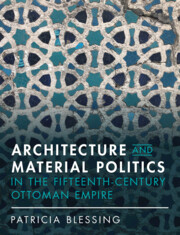Refine search
Actions for selected content:
12 results
Two cultures of interdisciplinarity
- Part of
-
- Journal:
- Cambridge Forum on AI: Culture and Society / Volume 1 / 2025
- Published online by Cambridge University Press:
- 23 October 2025, e1
-
- Article
-
- You have access
- Open access
- HTML
- Export citation
Saljuq Architecture in Iran: The Friday Mosque of Urmiya
-
- Journal:
- Iranian Studies / Volume 57 / Issue 1 / January 2024
- Published online by Cambridge University Press:
- 13 November 2023, pp. 3-26
- Print publication:
- January 2024
-
- Article
- Export citation

Architecture and Material Politics in the Fifteenth-century Ottoman Empire
-
- Published online:
- 28 July 2022
- Print publication:
- 18 August 2022
2 - Monument, Memory, and Remembrance: Rethinking the Masjid Through Contemporary Heritage Regimes
-
- Book:
- The Masjid in Contemporary Islamic Africa
- Published online:
- 05 August 2021
- Print publication:
- 29 July 2021, pp 79-131
-
- Chapter
- Export citation
Introduction
-
- Book:
- The Masjid in Contemporary Islamic Africa
- Published online:
- 05 August 2021
- Print publication:
- 29 July 2021, pp 1-27
-
- Chapter
- Export citation
5 - Creating Kemalism’s Tolerated Citizens via the Diyanet
- from Part I - Kemalism and Its Desired, Undesired, Tolerated Citizens
-
- Book:
- Creating the Desired Citizen
- Published online:
- 25 May 2021
- Print publication:
- 27 May 2021, pp 89-100
-
- Chapter
- Export citation
Paradox of Protective Behaviors Among Muslim Men During the Early Stage of the COVID-19 Pandemic in Aceh, Indonesia
-
- Journal:
- Disaster Medicine and Public Health Preparedness / Volume 16 / Issue 6 / December 2022
- Published online by Cambridge University Press:
- 06 April 2021, pp. 2438-2445
-
- Article
-
- You have access
- Open access
- HTML
- Export citation
5 - Muslim Identity and Group-Based Trust
- from Part I - Theoretical Development
-
- Book:
- Trust and the Islamic Advantage
- Published online:
- 31 August 2020
- Print publication:
- 03 September 2020, pp 94-122
-
- Chapter
- Export citation
6 - Explaining the Islamic Advantage in Political Participation
- from Part II - Applications and Empirics
-
- Book:
- Trust and the Islamic Advantage
- Published online:
- 31 August 2020
- Print publication:
- 03 September 2020, pp 125-147
-
- Chapter
- Export citation
The Ethical Substance of Salvation: Materiality and Religious Rejection of the World in a London Mosque
-
- Journal:
- European Journal of Sociology / Archives Européennes de Sociologie / Volume 61 / Issue 1 / April 2020
- Published online by Cambridge University Press:
- 29 June 2020, pp. 129-158
-
- Article
- Export citation
